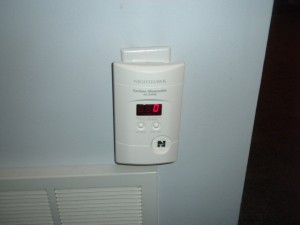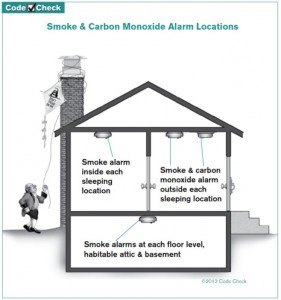This very cold winter has been responsible for many accidents, including deaths from CO (carbon monoxide) poisoning.
These disasters might have been averted if a properly located and operating carbon monoxide alarm had been installed. For just $25 a battery-operated or for $50 a hardwired alarm can be purchased and installed.
What is CO? Carbon monoxide is a toxic gas that is tasteless, odorless, invisible, and none irritating gas. It also weighs approximately the same per cubic foot as the air in your house. If it is going to poison you, you won’t know anything about it!
What causes CO? CO is a product of incomplete combustion due to an insufficient oxygen supply. This can occur by not supplying a fossil fuel burning appliance with enough air.  Your furnace, water heater, fireplace, automobile either needs to be located in a wide open space or have an outside air supply. There are formulas for how big an open space is needed, but by installing an outside air supply you are assured of having sufficient air for complete combustion. Or carbon monoxide occurs when fossil fuel appliance burners are incorrectly tuned or when the burner exhaust system is blocked or leaking. In other words you are re-burning the original exhaust products. A safe appliance produces carbon dioxide (CO2). Only when there is not enough oxygen in the air or when you re-burn oxygen from the CO2 does the appliance become a CO producer.
Your furnace, water heater, fireplace, automobile either needs to be located in a wide open space or have an outside air supply. There are formulas for how big an open space is needed, but by installing an outside air supply you are assured of having sufficient air for complete combustion. Or carbon monoxide occurs when fossil fuel appliance burners are incorrectly tuned or when the burner exhaust system is blocked or leaking. In other words you are re-burning the original exhaust products. A safe appliance produces carbon dioxide (CO2). Only when there is not enough oxygen in the air or when you re-burn oxygen from the CO2 does the appliance become a CO producer.
All homes should have a CO detector within 10’ of all bedrooms.
What is the action level? Obviously you would like to have zero CO in your house. But that may not be possible; you should expect a level of less than 15 ppm in your home. Exposures at 100 ppm (parts per million) or greater can be dangerous to human health. At this level the symptom would be a slight headache in 2-3 hours of exposure. People who survive CO poisoning and complain of low to severe headaches and nausea are lucky. They just got a relatively low dose of this insidious poisoning. Elevated levels of CO will simply kill you before you know anything about it.
All systems that burn fossil fuels… Oil, Gas, Wood… should be examined and tuned by an expert annually.
Doug Hastings
MN Home Inspector, Minneapolis & St. Paul
ASHI certified inspector, ACI
Kaplan University, Home Inspection Lead Instructor
Rob ‘Pops’ Leslie
Kaplan Professionals, Retired



